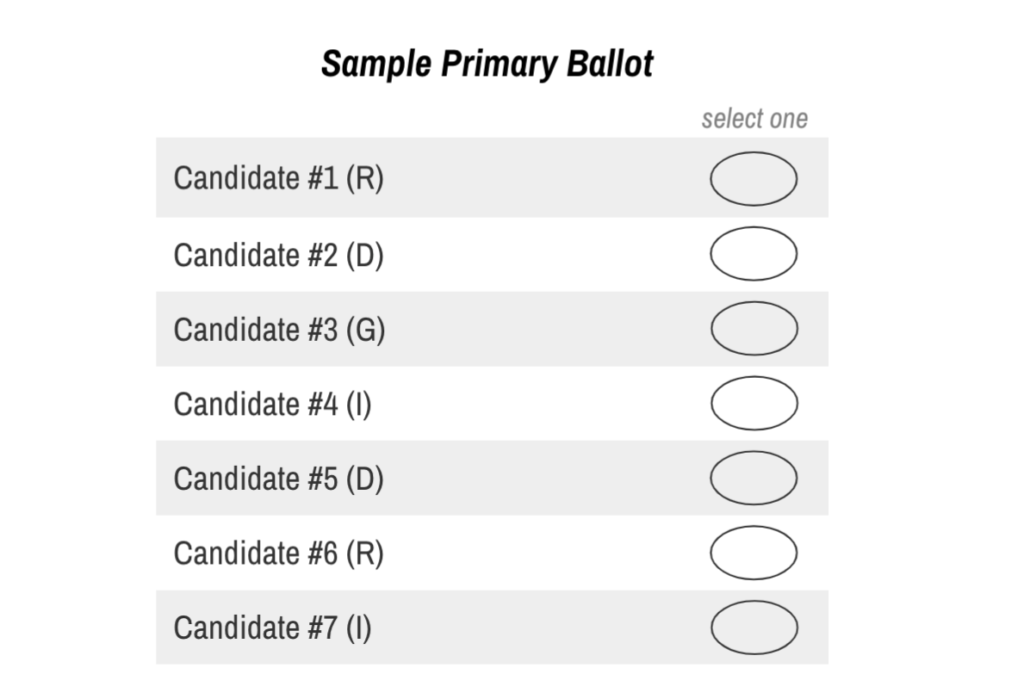Final Five Voting
Final Five Voting describes a new election system consisting of an open preliminary election to select a field of five candidates for each office followed by an instant-runoff general election to determine the majority winner.
The Final Five Voting concept was pioneered by IPI Founder Katherine Gehl, who is joined by leaders across the political spectrum as co-founder of The Campaign for Final Five Voting. Learn about the national campaign and active state campaigns at www.finalfivevoting.org.
Here’s how Final Five Voting works:
Fix #1: Eliminate party primaries
Instead, there is a single preliminary election open to all candidates and all voters regardless of party.

TOP FIVE MOVE ON
The top five finishers from the preliminary round advance to the general election.
TOP FIVE MOVE ON
The top five finishers out of this open primary advance to the general election.
Fix #2: Get rid of plurality voting
In the November general election, we use instant runoffs to narrow the five candidates to the final two candidates at which point majority wins.

Determining the winner
After the ballots are counted…
- The first-choice votes are tallied.
- A process of instant runoffs begins wherein the candidate in last place is eliminated.
- Voters who had ranked the eliminated candidate first, now have their single vote automatically transferred to their next choice of the remaining candidates.
- The votes are tallied again. And this runoff process continues until the field is narrowed to the final two candidates and the winner emerges with a true majority.
Video: How Final Five Voting Works
Passage
Article One of the U.S. Constitution vests states with the power to change their rules for Congressional elections as they see fit. There are two methods for change:
- All states can use the legislative route: the legislature passes a bill, which is then signed into law by the governor, to adopt Final Five Voting
- Approximately half the states can adopt Final Five Voting using ballot referenda (also known as ballot measures or ballot propositions) in which the citizens vote directly on the law, thereby bypassing the legislature.
See which states have the ballot option:
Passage
Article One of the U.S. Constitution vests states with the power to change their rules for Congressional elections as they see fit. There are two methods for change:
- All states can use the legislative route: the legislature passes a bill, which is then signed into law by the governor, to adopt Final-Five Voting
- Approximately half the states can adopt Final-Five Voting using ballot referenda (also known as ballot measures or ballot propositions) in which the citizens vote directly on the law, thereby bypassing the legislature.
Wyoming
Wisconsin
West Virginia
Washington
Virginia
Vermont
Utah
Texas
Tennessee
South Dakota
Rhode Island
Pennsylvania
South Carolina
Oregon
Oklahoma
Ohio
North Dakota
North Carolina
New York
New Mexico
New Jersey
New Hampshire
Nevada
Nebraska
Montana
Missouri
Mississippi
Minnesota
Michigan
Massachusetts
Maryland
Maine
Louisiana
Kentucky
Kansas
Iowa
Indiana
Illinois
Idaho
Hawaii
Georgia
Florida
Delaware
Connecticut
Colorado
California
Arkansas
Arizona
Alaska
Alabama
Custom State Template
FAQ
We want enough candidates in the general election for healthy, diverse competition but not so many that it’s confusing to the voter. Five is the “sweet spot” number. Five creates space for three more than the current system and, as a result lowers the “barriers to entry” (i.e., how hard it is and how much it costs to qualify for the general election) to make it easier for new competition to enter the race. Five increases the likelihood that innovative ideas, diverse candidates, and issue-focused candidates (those who may run to bring visibility to an issue) will enter the race and create a dynamic debate between the primary and the general. We cap it at five because with more than that it becomes substantively more difficult for voters to meaningfully distinguish between and develop opinions on a laundry list of candidates, and because we want to minimize the likelihood of what political scientists term “ballot exhaustion,” in which voters don’t rank all the candidates.

Final-Five Voting is both powerful (i.e. likely to substantively increase the likelihood that Congress can successfully address complex problems in a cross-partisan way) and achievable (i.e., can be implemented and impactful in a matter of years not decades). Most other reforms are less powerful or not as achievable or both. For example, reducing the influence of money in politics could require a constitutional amendment. Eliminating gerrymandering has been partisanized in a way that makes it far less achievable than our cross-partisan effort for Final Five Voting—and on its own, gerrymandering won’t affect incentives enough to increase problem-solving in Congress because primaries would still exist and forbid the two sides to work together. Additionally, Final Five Voting will—in most cases—lessen the negative effects of other systemic distortions like gerrymandering thereby reducing their negative impacts on our political system. Finally, over time, other reforms may become more powerful and/or achievable. Once we address key electoral incentives with Final Five Voting, it will be much easier (i.e., more achievable) to reach cross partisan agreement on additional reforms if they’re needed.
Final Five Voting is the combination of two innovations:
- Top-five primaries in which we don’t use ranked-choice voting (RCV) and;
- RCV general elections.
FFV’s power to increase the likelihood that Congress solves problems in the public interest comes from the combination of the two. On its own, RCV is dramatically less impactful because it simply doesn’t fix the incentives for problem solving that are created by party primaries. As such, Final Five Voting is not synonymous with ranked-choice voting.
Final Five Voting is not a trojan horse for partisan advantage—its implementation doesn’t benefit one “side” more than the other. As Katherine Gehl always says, “Final Five Voting is not designed to necessarily change who wins. It’s designed to change what the winners have the freedom to do and are incented to do—and on whose behalf they’re doing it.” Final Five Voting will reward candidates and parties that run the best campaigns, appeal to the most voters in the general election (not just to party primary voters as is the case in the current system) and do the better job of governing once in office. Surely you think that’s your party.

